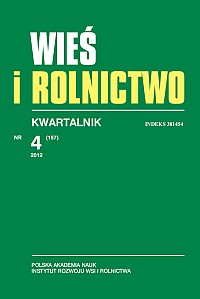Partnerstwo międzysektorowe czy kolejne narzędzie władz samorządowych? Ukryty sektor publiczny w lokalnych grupach działania w Polsce
Cross-sectoral partnership or just another instrument of local authorities? ”Hidden” public sector in local action groups in Poland
Author(s): Marek FurmankiewiczSubject(s): Social Sciences
Published by: Instytut Rozwoju Wsi i Rolnictwa Polskiej Akademii Nauk
Keywords: cross-sectoral partnership; local councils; domination of the public sector; partnerstwo międzysektorowe; władze samorządowe; dominacja sektora publicznego
Summary/Abstract: Basing on a sample of 45 randomly selected local action groups (LAGs) a survey of members of decision-making councils (including 668 board members of LAGs) was conducted. It showed that the share of municipal mayors, heads of offices and employees of public entities was higher on average by 19% than that stated in formal documents. In 27 out of the 45 investigated LAGs (60%) the public sector, in fact, had a share of over 50% in the composition of LAGs and was assured a majority in voting for the selection of local projects supported within the framework of the so-called 4th “LEADER” axis of the Rural Development Program. In 30 out of the 45 investigated LAGs (66%) cases of subordination of board members were revealed (usually mayors and officers subordinated to them indicated as representatives of the social sector). Sometimes mayors and their deputies submitted declarations of being the "representatives of the social sector." These phenomena were observable throughout the country and there was no statistically significant difference between various historical and cultural regions in the "hiding" of the public sector. The paper discusses the causes and consequences of the domination of the public sector in the decision-making bodies of LAGs. W oparciu o próbę 45 losowo wybranych lokalnych grup działania (dalej: LGD) wykonano telefoniczne badania kwestionariuszowe członków tzw. rad decyzyjnych (łącznie 668 członków rad LGD), która wykazała, iż udział wójtów/burmistrzów, pracowników urzędów i kierowników podmiotów publicznych jest wyższy od deklarowanego średnio o 19%. W 27 na 45 badanych LGD (60%) sektor publiczny przekraczał w rzeczywistości 50% składu rady LGD i miał zapewnioną większość w głosowaniach dotyczących wyboru projektów lokalnych wspieranych w ramach tzw. osi 4 LEADER Programu Rozwoju Obszarów Wiejskich. W 30 na 45 badanych LGD (66%) stwierdzono przypadki podległości służbowej członków rad (zwykle w jednej radzie wójtowie/burmistrzowie i podlegli im pracownicy urzędu gminy wykazywani jako przedstawiciele sektora społecznego). Czasami także wójtowie/burmistrzowie i ich zastępcy przedstawiali pełnomocnictwa lokalnych organizacji jako „przedstawiciele sektora społecznego”. Zjawiska te występowały w całej Polsce i nie wykazano istotnych statystycznie różnic pomiędzy regionami historyczno-kulturowymi w „ukrywaniu” sektora publicznego. Dyskutowane są przyczyny i konsekwencje dominacji sektora publicznego w organach decyzyjnych LGD.
Journal: Wieś i Rolnictwo
- Issue Year: 157/2012
- Issue No: 4
- Page Range: 112-127
- Page Count: 16
- Language: Polish

